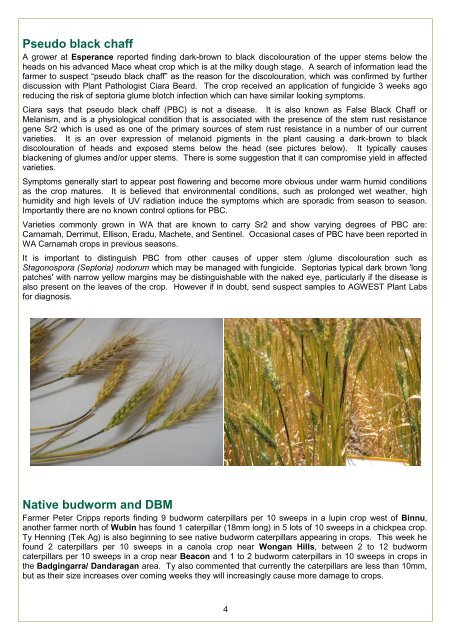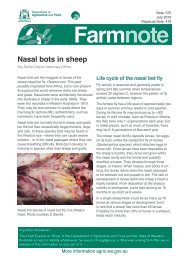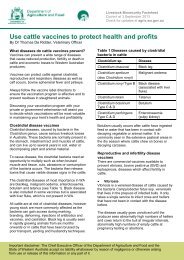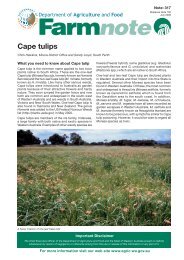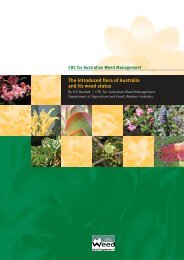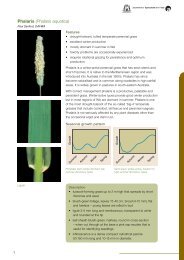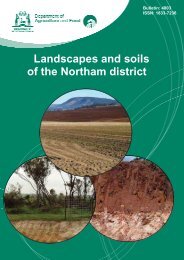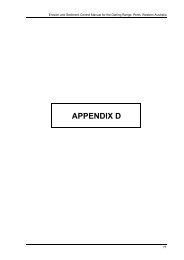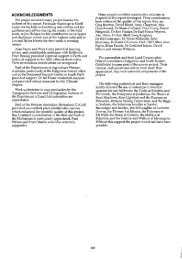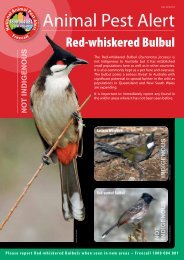PestFax No.18 06/09/13 - Department of Agriculture and Food - wa ...
PestFax No.18 06/09/13 - Department of Agriculture and Food - wa ...
PestFax No.18 06/09/13 - Department of Agriculture and Food - wa ...
Create successful ePaper yourself
Turn your PDF publications into a flip-book with our unique Google optimized e-Paper software.
Pseudo black chaff<br />
A grower at Esperance reported finding dark-brown to black discolouration <strong>of</strong> the upper stems below the<br />
heads on his advanced Mace wheat crop which is at the milky dough stage. A search <strong>of</strong> information lead the<br />
farmer to suspect “pseudo black chaff” as the reason for the discolouration, which <strong>wa</strong>s confirmed by further<br />
discussion with Plant Pathologist Ciara Beard. The crop received an application <strong>of</strong> fungicide 3 weeks ago<br />
reducing the risk <strong>of</strong> septoria glume blotch infection which can have similar looking symptoms.<br />
Ciara says that pseudo black chaff (PBC) is not a disease. It is also known as False Black Chaff or<br />
Melanism, <strong>and</strong> is a physiological condition that is associated with the presence <strong>of</strong> the stem rust resistance<br />
gene Sr2 which is used as one <strong>of</strong> the primary sources <strong>of</strong> stem rust resistance in a number <strong>of</strong> our current<br />
varieties. It is an over expression <strong>of</strong> melanoid pigments in the plant causing a dark-brown to black<br />
discolouration <strong>of</strong> heads <strong>and</strong> exposed stems below the head (see pictures below). It typically causes<br />
blackening <strong>of</strong> glumes <strong>and</strong>/or upper stems. There is some suggestion that it can compromise yield in affected<br />
varieties.<br />
Symptoms generally start to appear post flowering <strong>and</strong> become more obvious under <strong>wa</strong>rm humid conditions<br />
as the crop matures. It is believed that environmental conditions, such as prolonged wet weather, high<br />
humidity <strong>and</strong> high levels <strong>of</strong> UV radiation induce the symptoms which are sporadic from season to season.<br />
Importantly there are no known control options for PBC.<br />
Varieties commonly grown in WA that are known to carry Sr2 <strong>and</strong> show varying degrees <strong>of</strong> PBC are:<br />
Carnamah, Derrimut, Ellison, Eradu, Machete, <strong>and</strong> Sentinel. Occasional cases <strong>of</strong> PBC have been reported in<br />
WA Carnamah crops in previous seasons.<br />
It is important to distinguish PBC from other causes <strong>of</strong> upper stem /glume discolouration such as<br />
Stagonospora (Septoria) nodorum which may be managed with fungicide. Septorias typical dark brown 'long<br />
patches' with narrow yellow margins may be distinguishable with the naked eye, particularly if the disease is<br />
also present on the leaves <strong>of</strong> the crop. However if in doubt, send suspect samples to AGWEST Plant Labs<br />
for diagnosis.<br />
Native budworm <strong>and</strong> DBM<br />
Farmer Peter Cripps reports finding 9 budworm caterpillars per 10 sweeps in a lupin crop west <strong>of</strong> Binnu,<br />
another farmer north <strong>of</strong> Wubin has found 1 caterpillar (18mm long) in 5 lots <strong>of</strong> 10 sweeps in a chickpea crop.<br />
Ty Henning (Tek Ag) is also beginning to see native budworm caterpillars appearing in crops. This week he<br />
found 2 caterpillars per 10 sweeps in a canola crop near Wongan Hills, between 2 to 12 budworm<br />
caterpillars per 10 sweeps in a crop near Beacon <strong>and</strong> 1 to 2 budworm caterpillars in 10 sweeps in crops in<br />
the Badgingarra/ D<strong>and</strong>aragan area. Ty also commented that currently the caterpillars are less than 10mm,<br />
but as their size increases over coming weeks they will increasingly cause more damage to crops.<br />
4


